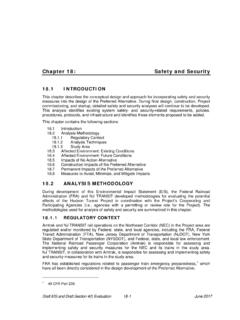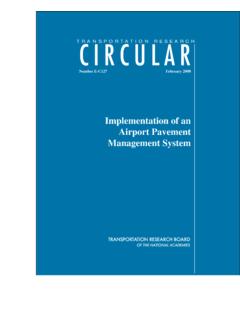Transcription of S.1 INTRODUCTION - Hudson Tunnel Project
1 Executive Summary INTRODUCTION . The Federal Railroad Administration (FRA) and New Jersey Transit Corporation (NJ TRANSIT). as joint lead agencies are preparing an Environmental Impact Statement (EIS) to evaluate the Hudson Tunnel Project (the Project ) in accordance with the National Environmental Policy Act (NEPA) of 1969 (42 USC 4321 et seq.). The Proposed Action is intended to preserve the current functionality of the Northeast Corridor's (NEC) Hudson River passenger rail crossing between New Jersey and New York and strengthen the resilience of the NEC. The Project 's Preferred Alternative includes construction of a new rail Tunnel under the Hudson River, including railroad infrastructure in New Jersey and New York connecting the new rail Tunnel to the existing NEC, and rehabilitation of the existing NEC Tunnel beneath the Hudson River. The Project Sponsor that will advance the Project through final design and construction, including compliance with mitigation measures, has not yet been identified.
2 The Project Sponsor may include one or more of the Port Authority of New York & New Jersey (PANYNJ), the National Railroad Passenger Corporation (Amtrak), NJ TRANSIT, and/or another entity that has not yet been determined. The Project Sponsor, once identified, will be responsible for ensuring all commitments and mitigation measures presented in the Environmental Impact Statement (EIS) and Record of Decision (ROD) are implemented. The Project Sponsor is expected to pursue Federal financial assistance from the Department of Transportation, including through the FRA or the Federal Transit Administration (FTA). Prior to issuing permits or approvals for a Project , including approval of funding, Federal agencies must consider the environmental effects of their actions under NEPA. Accordingly, FRA and NJ TRANSIT prepared this Draft EIS (DEIS) to comply with the requirements of the Council on Environmental Quality's (CEQ) regulations implementing NEPA (40 CFR Parts 1500.)
3 1508), the FRA Procedures for Considering Environmental Impacts (FRA's Environmental Procedures, 64 FR 28545, May 26, 1999, as updated in 78 FR 2713, January 14, 2013), and the Federal Highway Administration (FHWA) and FTA Environmental Impact and Related Procedures (23 CFR Part 771). The DEIS also documents compliance with other applicable Federal, New Jersey and New York State, and local environmental laws and regulations. Where relevant, the analysis was conducted to also meet the requirements of the NEPA procedures of the two Cooperating Agencies for the Project the FTA and the Army Corps of Engineers (USACE) as well as the requirements of other state and local agencies from which permits or approvals may be sought. Consistent with those regulations and procedures, this DEIS identifies the direct and indirect effects the Project would have on social, economic, and environmental conditions in the study area; and measures to avoid, minimize, or mitigate adverse impacts.
4 The existing NEC rail Tunnel beneath the Hudson River is known as the North River Tunnel . Figure S-1 illustrates the location of the North River Tunnel and its approach tracks. This Tunnel is used by Amtrak for intercity passenger rail service and by NJ TRANSIT for commuter rail service. The Tunnel operates at capacity to meet current demands. The existing tracks of the NEC within the Project area begin east of NJ TRANSIT's Frank R. Lautenberg Secaucus Junction Station in Secaucus, New Jersey, continue on a raised embankment through the New Jersey Meadowlands in Secaucus and North Bergen, New Jersey, and enter the North River Draft EIS and Draft Section 4(f) Evaluation S-1 June 2017. 6/14/2017. West New York Secaucus V. U. 3. New Jersey North r ve Bergen . 1. Ri .. on 9. ds Hu .. 95. Union City Weehawken V. U. 495. New York Meadowlands Palisades V. U 9A. ! H. Secaucus Junction Station Hudson River Waterfront West Midtown Jersey City H. ! Penn Station New York Hoboken Kearny 0 5,000 FEET.
5 Existing Northeast Corridor Existing North River Tunnel Project Location Project . Figure S-1. 1. Tunnel portal at the western face of the Palisades in North Bergen. The existing NEC passes beneath Union City and Weehawken, New Jersey and the Hudson River before emerging at Penn Station New York (PSNY) in New York City. The North River Tunnel actually consists of two separate tunnels (each referred to as a tube ), each accommodating a single track for electrically powered trains. In October 2012, seawater from Superstorm Sandy inundated the North River Tunnel . Damage caused by Superstorm Sandy is compounded by the Tunnel 's age (over 100 years old) and the intensity of its current use, resulting in frequent delays due to component failures within the Tunnel . Today the Tunnel , while safe for use, remains compromised and requires emergency maintenance that disrupts service for hundreds of thousands of rail passengers throughout the region. Despite the ongoing maintenance, the damage caused by the storm continues to degrade systems in the Tunnel and can only be addressed through a comprehensive reconstruction of the Tunnel .
6 Project PURPOSE, NEED, GOALS, AND OBJECTIVES. Project PURPOSE. The purpose of the Hudson Tunnel Project is to preserve the current functionality of Amtrak's NEC service and NJ TRANSIT's commuter rail service between New Jersey and PSNY by repairing the deteriorating North River Tunnel ; and to strengthen the NEC's resiliency to support reliable service by providing redundant capability under the Hudson River for Amtrak and NJ TRANSIT NEC trains between New Jersey and the existing PSNY. These improvements must be achieved while maintaining uninterrupted commuter and intercity rail service and by optimizing the use of existing infrastructure. Project NEED. The existing North River Tunnel is a critical NEC asset and is the only intercity passenger rail crossing into New York City from New Jersey and areas west and south. This Tunnel , constructed between 1904 and 1908 and opened for service in 1910, is more than 100 years old and was designed and built to early 20th-century standards.
7 While the Tunnel is safe for use, service reliability through the Tunnel , already suboptimal because of the Tunnel 's age and antiquated standards, has been further compromised because of the damage to Tunnel components caused by seawater inundation during Superstorm Sandy in October 2012. Chlorides from the seawater remain in the Tunnel 's concrete liner, bench walls, and ballast, causing ongoing damage to these elements as well as to embedded steel, track and third rail systems, and signaling, mechanical and electrical components. The damage to the bench walls and ballast and track systems necessitates full portal-to-portal replacement of these elements, which form integrated systems running the length of the Tunnel . The existing two-track North River Tunnel is operating at its full peak period capacity With the lack of redundant capability across the Hudson River into PSNY, any service outage, either unplanned or for planned maintenance, can thus substantially reduce or suspend rail service, causing delays that cascade up and down the NEC and throughout NJ TRANSIT's commuter system, disrupting service for hundreds of thousands of passengers.
8 Because of the importance of the North River Tunnel to essential commuter and intercity rail service between New Jersey 1. The Palisades are a line of steep cliffs that run along the western side of the Hudson River from northeastern New Jersey into southern New York State. In North Bergen and Union City, the Palisades are approximately 300 feet above the land to their west and east. June 2017 S-2 Draft EIS and Draft Section 4(f) Evaluation Executive Summary and New York City, rehabilitation of the existing North River Tunnel needs to be accomplished without notable reductions in weekday service, and redundant capability must be provided in order to allow for future maintenance without significant service disruption. In summary, the Hudson Tunnel Project will address the following critical needs: Improve the physical condition and rehabilitate the existing North River Tunnel : Both tubes in the North River Tunnel were inundated with seawater during Superstorm Sandy in October 2012, resulting in the cancellation of all Amtrak and NJ TRANSIT service into New York City for five days.
9 The more than 100-year-old North River Tunnel , already in need of repair due to its age, has been further compromised as a result of the storm damage and service reliability has suffered. Preserve existing NEC capacity and functionality during rehabilitation of existing North River Tunnel : The need to maintain existing levels of rail service is critical as it supports intercity, regional, and local mobility and associated economic benefits regionally and nationally. Strengthen the NEC's resiliency to support reliable service by providing redundant capability at the critical Hudson River crossing, so as to reduce commuter and intercity rail delays caused by unanticipated events or routine maintenance: The lack of redundant capability across the Hudson River means that any service outage, either unplanned or for planned maintenance, results in substantial reductions to NEC reliability and on-time performance. Once the Project is constructed, maintenance can take place without these service disruptions.
10 GOALS AND OBJECTIVES. FRA and NJ TRANSIT established five goals and related objectives to address the Project purpose and need. The objectives further define the goals and provide specific and measurable means by which to evaluate the Project alternatives. Goal 1: Improve service reliability and upgrade existing Tunnel infrastructure in a cost-effective manner. Objective : Reduce infrastructure-related delays due to poor condition of the North River Tunnel following Superstorm Sandy. Objective : Rehabilitate the North River Tunnel to modern system standards. Goal 2: Maintain uninterrupted existing NEC service, capacity, and functionality by ensuring North River Tunnel rehabilitation occurs as soon as possible. Objective : Optimize use of existing infrastructure. Objective : Use conclusions from prior planning studies as appropriate and to the maximum extent possible. Objective : Avoid regional and national economic impacts associated with loss of rail service.





